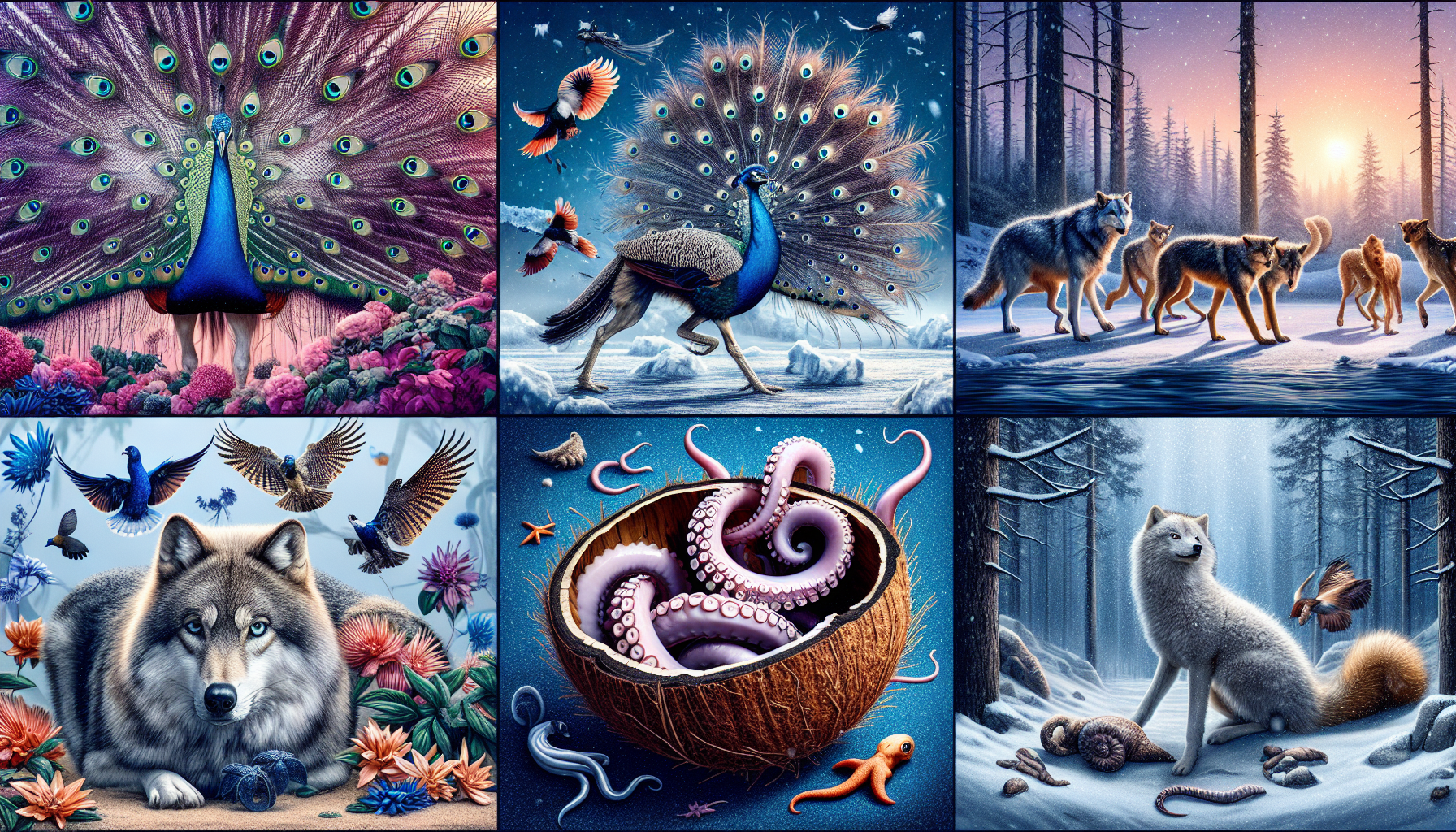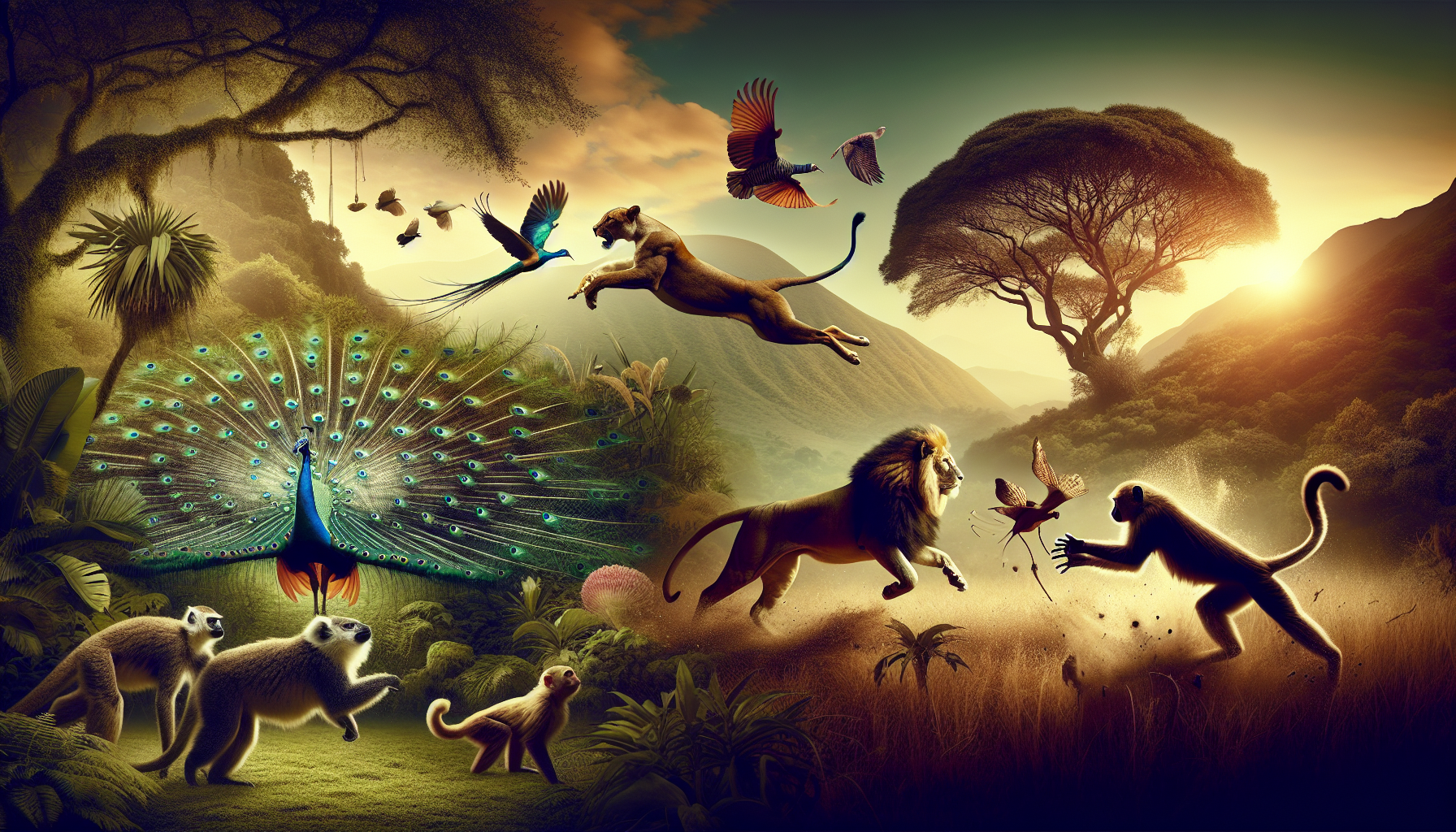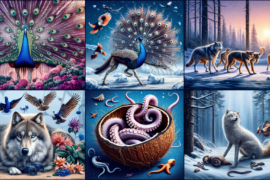You may think you know a lot about animals, but do you know about their most popular behaviors in the wild? From the fierce hunting tactics of predators to the intricate mating rituals of birds, the animal kingdom is full of fascinating behaviors that both entertain and amaze us. In this article, we will explore some of the most popular behaviors exhibited by animals in the wild, giving you a glimpse into their captivating world. So sit back, relax, and prepare to be amazed by the wonders of nature!

Hunting Techniques
Group Hunting
Group hunting is a fascinating behavior observed in many animal species. It involves individuals coming together to hunt and capture prey. This cooperative approach allows for more efficient hunting and increased chances of success. A great example of group hunting is seen in African lions, where females work together to surround and overpower their target. By coordinating their efforts, these mighty hunters are able to take down larger prey and ensure the survival of the pride.
Ambush Hunting
Ambush hunting is a strategy employed by predators that involves lying in wait for unsuspecting prey. This technique requires patience and stealth, as the hunter relies on surprise to catch its target off guard. One of the most skilled ambush hunters is the elusive leopard. With its ability to blend seamlessly into its surroundings and its remarkable agility, the leopard lies hidden among the foliage, waiting to pounce on its prey. This behavior allows the leopard to minimize energy expenditure while maximizing hunting success.
Chasing and Pursuit
Chasing and pursuit hunting is an exciting and energetic behavior seen in many predators. This technique involves relentlessly pursuing prey over long distances until the prey becomes exhausted or falls victim to the hunter’s speed and agility. Cheetahs, known as the fastest land animals, are exceptional at this form of hunting. With incredible acceleration and the ability to change direction rapidly, cheetahs can chase down their prey, reaching speeds of over 60 miles per hour in a matter of seconds. Their slender body and powerful muscles make them incredibly efficient hunters.
Tool Use in Hunting
Humans are not the only species that exhibit tool use. Many animals have shown remarkable intelligence and creativity in using tools to aid in their hunting efforts. For instance, some species of dolphins have been observed using sponges as protective coverings while foraging on the seabed, preventing injuries from sharp objects. Similarly, some birds, like the New Caledonian crow, use sticks to extract insects from tree crevices. Tool use in hunting demonstrates the cognitive abilities and adaptability of these animals.
Migration
Long-Distance Migration
Migration is a fascinating behavior observed in numerous animal species, allowing them to adapt and survive in changing environments. Some animals undertake long-distance migrations, often spanning thousands of miles, in search of more favorable conditions for breeding, feeding, or simply to avoid harsh weather conditions. The iconic journey of the monarch butterfly comes to mind, as these delicate insects travel up to 3,000 miles from North America to Mexico to escape the cold winter months. This incredible feat of endurance and navigation showcases the remarkable adaptability of animals.
Seasonal Migration
Seasonal migration is a behavior commonly observed in birds, but also in other animal species. It involves moving between different habitats on a regular basis in response to changing seasons. Many bird species migrate to breed in temperate regions during the summer and then return to warmer regions during the winter. This allows them to take advantage of abundant food sources and avoid harsh weather conditions. The Arctic tern holds the record for the longest migration, traveling from the Arctic to the Antarctic and back every year, covering a distance of around 50,000 miles. Seasonal migration is crucial for the survival and reproductive success of these animals.
Altitudinal Migration
Altitudinal migration is a unique type of migration observed in mountainous regions, where animals move between different elevations to find suitable conditions for survival. As seasons change, temperature, food availability, and predation risks vary at different altitudes. Animals, such as the Himalayan tahr, migrate uphill during the warmer months to take advantage of lush vegetation, and then descend to lower altitudes during harsh winters to escape extreme temperatures. This behavior allows them to adapt to the challenges presented by high-altitude environments and maximize their chances of survival.
Territorial Behavior
Marking and Defending Territory
Territorial behavior is a common phenomenon among animals, where individuals mark and defend a specific area from intruders. Animals utilize various methods to mark their territory, such as scent marking, vocalizations, or physical displays. For example, wolves mark their territory by urinating on trees, rocks, or other prominent objects, leaving behind a scent that acts as a warning to other wolves. When their territory is threatened, wolves will fiercely defend it, ensuring the safety and resources available within their designated area.
Displaying Dominance
Dominance hierarchies are prevalent in many animal groups, often determining access to resources, mating opportunities, and social status. Dominant individuals establish their status through various displays of power, such as aggressive posturing, vocalizations, or even physical combat. Male elephants, for instance, display dominance by flaring their ears, trumpeting loudly, and engaging in wrestling matches with other males. This display of dominance helps maintain order within the group and ensures individuals have their rightful place in the hierarchy.
Boundary Intrusions
In the animal kingdom, territorial disputes can sometimes lead to boundary intrusions. When individuals from neighboring territories encroach upon each other’s space, conflicts can arise. These boundary intrusions can result in aggressive interactions, displays of dominance, or territorial vocalizations. One such example is observed in meerkats, small mammals that live in tight-knit clans. When rival groups approach their territory, meerkats will stand on their hind legs, flare their tails, and engage in high-pitched alarm calls to warn the intruders and protect their turf.
Parental Care
Nest Building and Preparation
Parental care is a crucial behavior exhibited by many animals, ensuring the survival and well-being of their offspring. One common form of parental care is nest building and preparation. Birds are well-known for their intricate and carefully constructed nests, made from various materials like twigs, leaves, and even spider webs to provide a safe and comfortable environment for their eggs and chicks. The careful selection of nesting sites and the meticulous construction of nests demonstrate the dedication and commitment of these avian parents.
Incubation and Hatching
Incubation is a vital aspect of parental care, particularly in species that lay eggs. The process of incubation involves the parent(s) keeping the eggs warm and protecting them until they hatch. Both male and female birds participate in incubation, taking turns to ensure a constant temperature for the developing embryos. Penguins, for example, form pairs and carefully incubate their eggs by balancing them on their feet and covering them with a warm layer of feathers. Through this nurturing behavior, birds facilitate the hatching process and give their young the best chance of survival.
Feeding and Protection
Once the offspring have hatched or been born, parental care extends to feeding and protecting the young. Animals make great efforts to provide their offspring with the necessary nutrition for growth and development. For instance, lions operate a system of cooperative hunting, where lionesses work together to bring down prey and provide food for their cubs. The protection aspect of parental care can be seen in the behavior of deer, where mothers keep a close watch over their fawns, hiding them in dense vegetation and defending them from potential predators. These nurturing behaviors are essential for the survival and future success of the offspring.

Communication
Vocalizations
Communication through vocalizations is a fundamental aspect of animal behavior. Different species have evolved unique vocalizations to convey various messages, such as alarm calls, mating calls, or territorial warnings. Whales, for instance, are known for their complex songs and intricate vocalizations, which can travel for miles underwater. These songs serve as a form of communication between individuals, allowing them to maintain social bonds, attract mates, and navigate their vast oceanic environment.
Scent Marking
Scent marking plays a significant role in communication among animals, particularly mammals. By leaving scent marks, animals can convey information about their identity, reproductive status, and territory ownership. You may have come across the distinctive scent markings of a male cat, spraying to mark his territory. Similarly, wolves use their urine and scent glands to mark their territory, ensuring clear boundaries and conveying vital information to other wolves in the area.
Body Language
Body language is a nuanced form of communication used by animals to convey messages through postures, gestures, and facial expressions. It enables animals to communicate dominance, submission, aggression, or friendliness, among other signals. Dogs, our faithful companions, have incredibly expressive body language. From wagging their tails to rolling over on their backs, dogs use subtle body movements to convey their emotions and intentions to both other animals and humans.
Visual Displays
Visual displays are extravagant behaviors exhibited during courtship or territorial disputes. These displays often involve vibrant colors, intricate patterns, or elaborate movements to capture the attention of potential mates or intimidate rivals. One notable example is the peacock’s courtship display. The male spreads his magnificent, iridescent tail feathers into a vibrant fan and performs a dance-like strut to attract the female’s attention. This visually stunning display is a testament to the role of visual signals in animal communication.
Mating Rituals
Courtship Displays
Courtship displays are rituals performed by animals to attract a mate and initiate the reproductive process. These displays often involve intricate movements, vocalizations, or visual signals that vary greatly among species. Birds of paradise are renowned for their elaborate courtship displays, where males flaunt their colorful plumage, perform acrobatic dances, and produce melodious calls to impress the females. These captivating displays play a pivotal role in mate selection and ensure successful reproduction.
Dancing or Strutting
Dancing or strutting is another fascinating behavior exhibited during courtship. It serves as an impressive display of strength, agility, and genetic fitness, capturing the attention of potential mates. The sage grouse, found in North America, engages in a spectacular performance during mating season. The males inflate and expose their yellow air sacs, creating a mesmerizing pattern of puffs and bursts synchronized with their unique calls. This extravagant display is a testament to the importance of elaborate behaviors in the process of courtship.
Song or Vocalization
Song or vocalization is a common element of mating rituals in many species. Males use their voices to serenade potential mates, asserting their fitness and attractiveness. The melodious songs of birds are a prime example of this behavior. Nightingales, known for their beautiful and complex songs, engage in singing contests to establish dominance and attract females. These harmonious serenades showcase a male’s genetic quality and serve as a crucial aspect of courtship.
Gift Giving
Gift giving might not be exclusive to humans; some species engage in this behavior during courtship as well. Male animals offer gifts, commonly food or other valuable resources, to potential mates as a display of their ability to provide and invest in the offspring. The male bowerbird, known for its impressive architectural skills, builds intricate structures called bowers and decorates them with colorful objects and prized possessions. These elaborate displays serve as gifts to attract females and demonstrate the male’s dedication to reproduction.
Social Hierarchies
Alpha Dominance
Social hierarchies are prevalent in many animal groups, with individuals occupying different ranks within a group. In some cases, an alpha individual sits at the top of the hierarchy and holds the highest rank, asserting control over the group’s resources and decision-making. Wolves exemplify this social structure, where a dominant pair, the alpha male and female, lead the pack. The alpha pair ensures order, coordinates group activities, and maintains harmony within the wolf pack.
Subordinate Ranks
Alongside the dominant individuals, animals within a social hierarchy occupy subordinate ranks, with varying degrees of access to resources and status. Subordinate individuals often follow the lead of the dominant individuals and adhere to social rules within the group. In meerkat societies, for example, alpha individuals hold top positions, while subordinates assist in tasks such as foraging, babysitting, and keeping watch for predators. Subordinate ranks ensure the smooth functioning of the group, cooperation, and division of labor.
Cooperative Behaviors
Cooperative behaviors are vital for the success and survival of many animal species. The mutual assistance and collaboration within social groups increase overall fitness and aid in achieving common goals. Honeybees are an excellent example of cooperative behavior in action. Worker bees tirelessly gather nectar, pollinate, and care for the hive, while the queen bee focuses on reproduction. This division of labor and cooperation allows honeybee colonies to thrive and maintain the delicate balance required for their survival.
Foraging Strategies
Scavenging
Scavenging is a foraging strategy that involves feeding on the remains of dead animals. Many animals, such as vultures and hyenas, have adapted to this unique niche in the ecosystem. Scavengers play a crucial role in nutrient recycling, cleaning up carcasses, and preventing the spread of diseases. They possess specialized adaptations, such as strong stomach acids to digest decaying meat, powerful beaks or teeth to tear into tough flesh, and an acute sense of smell to locate carcasses from great distances.
Digging
Digging is a foraging strategy utilized by a variety of animals, allowing them to access food sources that are buried or hidden underground. From squirrels burying nuts to be retrieved later to anteaters using their long claws to unearth ants and termites, digging enables animals to find hidden treasures that would otherwise be inaccessible. This strategy requires strength, coordination, and specialized anatomical features to effectively extract and procure food.
Filter Feeding
Filter feeding is a feeding strategy employed by certain species to extract food particles from water or air by filtering them through specialized structures. Baleen whales, for instance, have baleen plates hanging from their upper jaws, acting as a filter to trap and retain small marine organisms like krill. As they swim with their mouths open, water passes through the baleen, leaving behind the nutritious food items. This energy-efficient method allows these gentle giants to acquire large amounts of food with each skim through the water.
Tool Use in Foraging
Tool use is not limited to hunting; many animals also employ tools during foraging to obtain food more efficiently. One striking example is the sea otter, which uses rocks to crack open shellfish. The otter balances a rock on its chest, energetically smashing the shellfish against it to access the tasty meal inside. This behavior showcases the resourcefulness and problem-solving abilities of animals, as they adapt and use tools to overcome challenges in their search for food.
Defensive Behaviors
Camouflage
Camouflage is a defensive behavior employed by animals to blend seamlessly into their surroundings, allowing them to remain undetected by predators or prey. Many animals have evolved specialized coloration or patterns on their bodies to enhance camouflage. The walking stick insect, for instance, possesses a long, slender body and intricate patterns that mimic twigs or branches, making it nearly invisible to predators and providing effective protection.
Mimicry
Mimicry is a fascinating defensive behavior where one animal evolves to resemble another species, often for protection against predators or to gain an advantage in obtaining food. The monarch butterfly, for example, has evolved vibrant orange and black wing patterns, warning potential predators of their toxic taste. The viceroy butterfly, on the other hand, has evolved to mimic the monarch’s appearance, thereby gaining protection from predators who have learned to avoid the monarch through trial and error.
Warning Displays
Warning displays are defensive behaviors performed by animals to deter potential threats. These displays typically involve a visual cue or vocalization that signals danger, warning other animals of an impending attack or the presence of toxic substances. The rattlesnake, known for its venomous bite, utilizes a warning display by vibrating its rattle when it feels threatened. This sound serves as an effective deterrence, alerting potential predators to the danger and giving them a chance to retreat.
Fight or Flight
Fight or flight is a common response to perceived threats, where animals must decide whether to confront their attacker or flee to safety. This defensive behavior is driven by the instinct for self-preservation and survival. When faced with danger, animals evaluate the odds and choose between engaging in combat or making a swift escape. For instance, when a prey animal spots a predator, it must make a split-second decision to either stand its ground and defend itself or take flight to evade capture.
Sleep Patterns
Nocturnal Behavior
Nocturnal behavior refers to animals that are primarily active during the night and sleep during the day. Many nocturnal animals have adapted to low-light conditions, possessing enhanced night vision, acute hearing, or specialized sensory adaptations. Fascinating creatures like owls, bats, and certain primates are nocturnal, utilizing the cover of darkness to avoid predators, hunt for prey, or engage in other activities naturally suited to the nighttime environment.
Diurnal Behavior
Unlike nocturnal animals, diurnal animals are primarily active during the day, with their sleep patterns shifting to nighttime. These animals have adapted to the light levels and environmental conditions present during the day, allowing them to forage, reproduce, and interact with others in their diurnal habitats. Most bird species, as well as many mammals like squirrels and deer, exhibit diurnal behavior, taking full advantage of daylight hours to fulfill their needs.
Power Napping
Power napping is a sleep pattern observed in some animals that allows them to obtain sufficient rest in short bursts. Rather than engaging in long periods of uninterrupted sleep, these animals take advantage of strategic naps throughout the day to replenish their energy. Cats are famous for their power napping skills, snoozing for short periods and quickly recharging themselves for their next hunting or playtime adventure. Power napping allows animals to meet their sleep requirements while remaining alert and ready for action.
